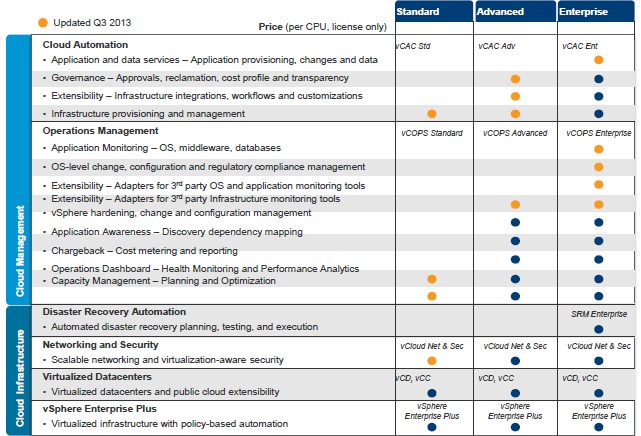VMware Ships vSphere 5.5 Server Virtualization Wares

Server virtualization giant VMware has started shipping its latest iteration of its hypervisor and the tools that augment it, and is also now peddling further automate and orchestrate the hypervisors and VMs running on that virtual infrastructure.
Both products were announced at the end of August at the annual VMworld extravaganza that VMware hosts, and they are the means by which the company hopes to leverage its dominant position in server virtualization in the corporate data centers of the world to create a multi-billion dollar cloud management business. This is what VMware refers to as the software-defined data center, or SDDC, and the aim is to fully virtualize compute, storage, and networking and make a data center programmatically manageable in a way that is orchestrated across these three components in a seamless fashion.
vSphere 5.5 is the core server virtualization product, and it is based on the ESXi 5.5 hypervisor. (VMware doesn't like to admit there is a hypervisor down in there, and doesn't even mention ESXi by name any more, but it is in there.) First and foremost, that new hypervisor is able to span larger servers. You can read all of the gory details in the vSphere 5.5 configuration maximums document, but I will walk you through the important capacity increases.
On the hypervisor itself, the number of logical CPUs that ESXi 5.5 can address is now 320, up from 160 with ESXi 5.1, which came out last summer. The number of sockets a single system image can have in a NUMA configuration is also doubled to 16 with the latest hypervisor, and main memory addressable by the hypervisor is also doubled to 4 TB. The maximum number of virtual CPUs (vCPUs in the VMware lingo) that can be carved out from the physical cores or threads on a single machine went up by a factor of two as well, to 4,096. In short, this x86 hypervisor has plenty of room to grow as Intel and Advanced Micro Devices crank up the cores on their processors.
The virtual machines also have their own limits, of course, and with the 5.5 release, the virtual memory available to an operating system inside the VM stays the same at 1 TB and the number of vCPUs that can be allocated to it is also the same at 64. The one big change here is that you can now allocate 64 TB of virtual disk to a VM, up from 2 TB with the prior release.
The ESXi 5.5 hypervisor has a number of interesting features, which should be able to significantly boost performance of virtualized machines above and beyond the capacity increases above. The first is called vSphere Flash Read cache, and it uses flash memory located in either solid state drives or in PCI-Express cards as a read cache for both the hypervisor and its virtual machines. You can carve up slices of flash for each VM on the box, or only give it to some of them to boost their performance. vSphere 5.5 also allows for hot-plugging of SSDs (you could already do it with disk drives).
More importantly for extreme cases, VMware has put in some dials and knobs to allow for the hypervisor to be tuned specifically for low-latency applications, with in-memory databases being only one example.
Finally, the new hypervisor also includes the "Project Serengeti" extensions for automating the deployment of Hadoop on top of virtual machines. Now that this software, which has been available for quite some time as an unsupported project, is commercially available, it is being given a properly boring name of Big Data Extensions. These extensions for putting Hadoop compute and data nodes as well as NameNode and JobTracker nodes into virtual machines are now part of the vSphere Enterprise and Enterprise Plus hypervisor editions.
The vSphere/ESXi hypervisor comes in three editions, with the Standard Edition costing $995 per socket, the Enterprise Edition (which layers in resource management features) costing $2,875 per socket, and the full-on Enterprise Plus (which adds policy management automation for VMs and hypervisors) costing $3,495 per socket. If you want to add in Operations Management on top of these editions, which adds proactive management of the cluster so VMs and their applications do not experience downtime, then add another $750 to each license. And a reminder: These prices include the dreaded Virtual Memory Tax, with each license having a cap for virtual CPU and memory; if you go above these limits, you have to buy additional licenses on the same physical server.
If you want to get away from those CPU and memory limits, then VMware strongly suggests that you buy its vCloud Suite, which takes the Enterprise Plus hypervisor and the Operations Management tools and weaves them together with vCenter Cloud Automation and a bunch of security, disaster recovery, and public cloud extensions to get you right up to – but not quite – a full-on private cloud. (You have to buy vCloud Director to really be a fully orchestrated cloud.) Here is how vCloud Suite Stacks up in its own editions:
The Standard Edition of vCloud Suite costs $4,995 per processor socket, while the Advanced Edition costs $7,495 per socket and the Enterprise Edition costs $11,495. There are a number of lessons to learn from this pricing. First, none of this virtualization and management software from VMware is cheap; it is in many cases much more expensive than an operating system and approaches the cost of an enterprise-grade relational database on a two-socket server.
The other important lesson is to pick your licenses and editions carefully, and to watch out for the CPU and memory tax. And finally, the last lesson is that it is good to be VMware if it can get anything even close to these prices – particularly in a world where Xen and KVM can be free or at least very inexpensive and the OpenStack cloud controller plays very nicely with them as an orchestrator and where Microsoft is competing very aggressively with its Hyper-V/System Center combination.
VMware is not yet shipping its NSX virtual network and security software, which is part of the vSphere 5.5 product cycle and which will link hypervisors with virtual switches to each other across physical switches and routers into a logical L2 switch and a logical L3 router with centralized control of the forwarding and routing tables for that gear. That software is set to ship sometime in the fourth quarter, and when we see the packaging and pricing for NSX, we will drill down into it.











